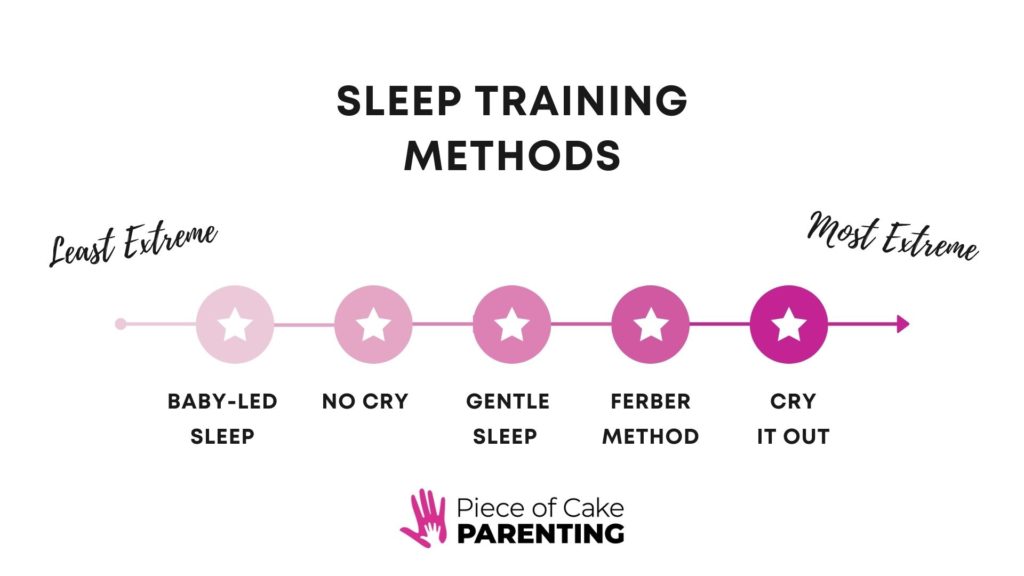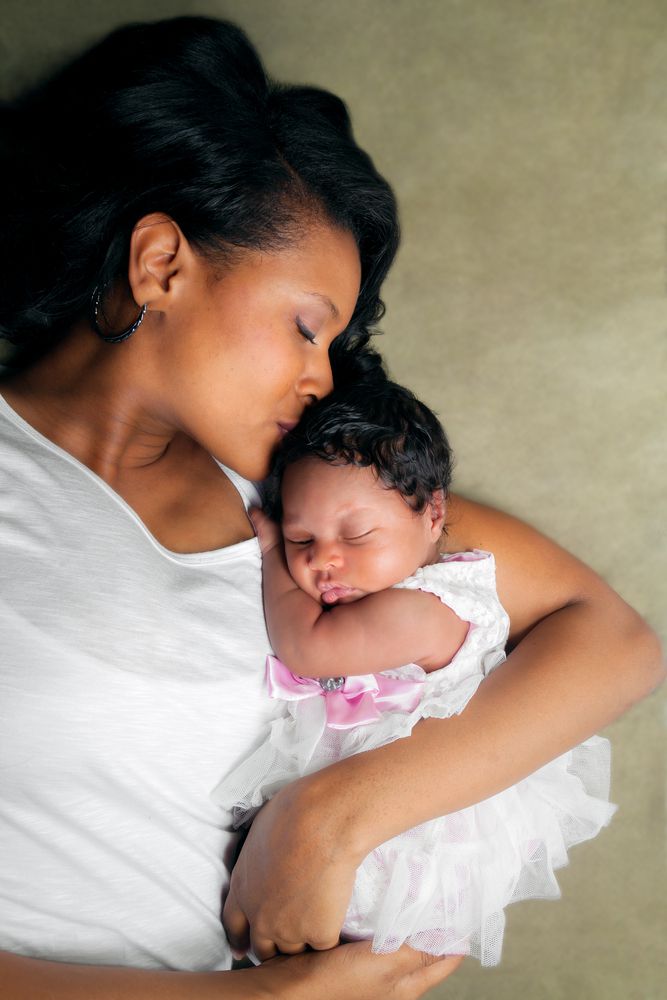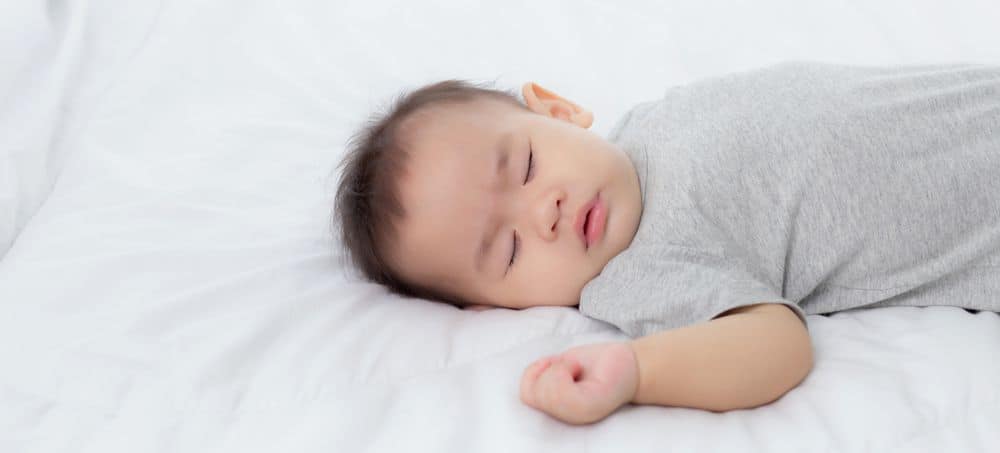As you try to figure out your baby’s sleep once and for all, you’ve probably heard people throw out terms like cry it out, gentle sleep training, baby-led sleep, and the Ferber method. But what do all of these mean? And how do you figure out what method is best for your family?
There’s multiple approaches to sleep training because all babies and all families are different. Before you start sleep training, it’s important to understand all of your options so you know exactly what each style looks like, what you can expect if you select each sleep training style, and how to pick the best option for your family.
Jump To:
🥱 Top 5 Sleep Training Methods 🥰 Baby-Led Sleep Approach What does the Baby-Led Sleep process look like? How much crying is involved with Baby-Led Sleep? Is the Baby-Led Sleep approach best for you? 💤 No Cry Approach What does the no cry approach process look like? How much crying is involved with no cry approach? Is the no cry approach best for you? 🤗 Gentle Sleep Training Approach What does the Gentle Sleep Training process look like? How much crying is involved with the Gentle Sleep Training process? Is the Gentle Sleep Training approach best for you? 👶 Ferber Method What does the Ferber Method process look like? How much crying is involved with the Ferber Method? Is the Ferber Method best for you? 😴 Cry It Out Approach What does the Cry It Out process look like? How much crying is involved with Cry It Out? Is Cry It Out best for you? 💭 Final Thoughts
DISCLOSURE: Piece of Cake Parenting may receive a commission for purchases made through links in this post. Read more about these links in my disclaimer policy.

Top 5 Sleep Training Methods
The best sleep training method for your family depends on your baby’s personality, your parenting approach, and your own personal preference.
In this post, I’m going to explain all of the methods of sleep training from least strict to most strict, reveal how much crying is involved with each method, and help you decide which approach to try out with your little one.
Let’s get started!

1. Baby-Led Sleep Approach (Also known as Attachment-Focused Sleep, Holistic Sleep)
The baby-led sleep approach is a holistic approach that encourages parents to listen to their instincts and their baby’s cues.
Baby-Led Sleep is the only approach on this list that isn’t actually considered sleep training at all.
Rather than slapping a bandaid over the root causes of your child’s sleep challenges, the baby-led sleep model empowers parents to understand normal biological sleep for infants and toddlers, to lean into their child’s attachment needs, and identify root causes and specific solutions for any sleep red flags that you see in your child.
What does the Baby-Led Sleep process look like?
Because the baby-led sleep approach is highly individualized, it often works best to work 1:1 with a certified Baby-Led Sleep and Well-Being Specialist. Myself and everyone else who’s completed the Baby-Led Sleep and Well-Being Certification Program have completed 6+ months of training and education and have previously worked 1:1 with other families.
When you work with your Baby-Led Sleep and Well-Being Specialist, you typically perform a comprehensive intake assessment to identify your sleep challenges and goals. Then you’ll work 1:1 with your sleep specialist to identify a sleep education plan that helps you keep what’s working, shift what’s not working, and remain responsive to your child throughout the entire process.
⭐ If you’re not interested in a 1:1 package, there are also more and more options each month for courses and webinars that cover the foundations of baby-led sleep or specific questions related to sleep.
How much crying is involved with Baby-Led Sleep?
Although the baby-led sleep approach is highly responsive, it is not a no-cry sleep solution. Throughout the program, you’ll learn the importance of tears and allowing your child to safely express all emotions and feelings.
Rather than stifling your child’s emotions or shutting down their attempts to cry, you’ll learn the different types of cries and how to support your child to have emotions and express frustrations while staying with them, supporting them, and responding to their needs 100% of the time.
⭐ Depending on your child, their emotions, and the specific sleep shifts you are working on with your little one, you will see varying amounts of crying. However, you will never be asked to leave your child to cry alone, to ignore their cries, or to cry it out for even one minute at any point throughout the baby-led sleep approach.
Is the Baby-Led Sleep Approach Best For You?
The baby-led sleep approach to supporting your child’s sleep challenges is best for parents who are looking to remain connected with their child day and night and who are striving to foster a strong, secure attachment with their child.
It’s the only approach for parents who value normal biology and want to focus on developmentally appropriate goals and milestones while making changes to your baby or toddler’s sleep.
It’s also a wonderful approach for parents who value communication and want to build the strongest foundation of communication and positive mental health for their child that begins during infancy and continues as their child grows.
Because the baby-led sleep approach focuses on identifying and truly addressing the root causes of any sleep challenges, combined with supporting attachment and emotions, it is best for parents who are patient and willing to work through each piece of the process without expecting radical changes that often come with extinction-based approaches to sleep.
*In the spirit of full transparency, the baby-led sleep approach is the only approach to sleep that I support and recommend because of the long-term impacts and positive benefits it has on current and future mental health for our children.
2. No Cry Approach
The No Cry approach to sleep training aims to have the least amount of crying possible while supporting changes to your child’s sleep.
No Cry sleep training often builds in plenty of comfort and support for your child at bedtime, naptime, and overnight with the goal to eliminate crying as much as possible.

What does the no cry approach process look like?
No Cry sleep training utilizes some of the same techniques that you’ll see in the baby-led sleep approach or in gentle sleep training approaches. The main difference is that you’ll see a very high priority on using methods that prevent crying while making any sleep changes.
Because this approach also depends on your child’s temperament, it often includes a personalized sleep consulting program to work 1:1 with a sleep consultant to create your sleep plan.
⭐ It is important to note that the sleep training industry isn’t regulated. Anyone can state they are a sleep coach or sleep trainer without any training or certification. For coaches who are certified, these programs last from a few hours to several weeks of content, but they don’t have any specific accreditation process. Be very careful when selecting a sleep coach and try to understand exactly what training they’ve gone through before hiring.
How much crying is involved with the No Cry Approach?
The goal of the no cry approach is to completely eliminate crying. So in theory, there would be no crying for your child at any point throughout this process, even to the extreme of shutting down your child’s ability to communicate and openly express their feelings with you.
However, no cry sleep specialists are quick to admit that this does depend on your child’s temperament and that most children do have some level of crying throughout the process.
Is the No Cry Approach Best For You?
The No Cry Approach is the most enticing for families who cannot bear any level of crying or who become anxious when their child is crying and are looking for a solution that helps them sleep better without leaving their child to cry.
If this method does resonate with you, I would highly recommend checking out the differences between the No Cry Approach and the Baby-Led Sleep approach since Baby-Led Sleep prioritizes not leaving your child alone to cry, but also works with you to better understand the importance of emotions and is more responsive than the no cry approach.

3. Gentle Sleep Training Approach
Gentle Sleep Training focuses on progressively making changes to your child’s sleep to encourage independent sleeping rather than jumping right in to cry it out methods.
⭐ “Gentle” is a subjective thing that means very different things to different families. For some, it’s “gentle” to minimize crying. For others, it’s “gentle” to do the Ferber method because you’re checking on your child at certain time periods.
What does the Gentle Sleep Training process look like?
Gentle sleep training typically involves a handful of strategies aimed to minimize crying while also proclaiming to teach independent sleep.
Because the gentle sleep approach is less personalized than previous methods, you can work 1:1 with a sleep support person or you can find several different sleep programs online to walk you through the steps.
You’ll often receive advice to stop nursing your baby to sleep, use the pick up put down method to comfort your baby when they fuss and then put them back in their sleep space, or use the chair method to sit next to your child as they fall asleep but minimize or eliminate picking them up, soothing them, or talking to them.
How much crying is involved with Gentle Sleep Training?
Although advertisements for gentle sleep training typically emphasize that this approach is less crying than other methods, the amount of crying with gentle sleep training varies significantly from baby to baby.
Every family I’ve ever worked with who has done gentle sleep training programs states they’ve been surprised and highly disappointed by the amount of crying that was encouraged in these programs. So it is important to know that you will likely be asked to leave your child alone to cry at some point throughout the gentle sleep training process.
Is Gentle Sleep Training Best For You?
Gentle sleep training is best for families who are okay with a fair amount of crying but who want to be present and offer some support to their child throughout the sleep training process.
It’s also for babies with easy going personalities as this approach can be very challenging for many temperament styles and cause even more frustration for parents if it doesn’t align with their child’s personality.
⭐ Based on the disappointing feedback from other parents, I wouldn’t recommend starting with gentle sleep training unless you’ve talked 1:1 with the sleep support person at length about their philosophy and what’s included in their package or course BEFORE spending any money to avoid being disappointed by the advice that you receive.

4. Ferber Method (Also known as Graduated Extinction, Interval Method, and Check and Console)
The Ferber method is a baby sleep training program that was developed by Richard Ferber and that encourages parents to leave their baby alone for strictly-timed intervals without responding to any protests or cries they hear between timed checks.
What does the Ferber Method process look like?
The Ferber method focuses on teaching children to figure out sleep on their own. By denying access to their parents or caregivers, it’s determined to be effective when a child learns to be less disruptive during overnight wakings.
Because there’s no personalization to the Ferber method, you typically don’t have to work 1:1 with anyone and can take a course or follow a diagram online with instructions on how often to check on your child.
The schedule typically looks something like this:
- Put your baby in bed and leave the room for 3 minutes. Do not re-enter before the 3 minute mark no matter what you hear.
- Briefly check on your child, while refraining from picking up your child, and then leave the room again for 5 minutes. Do not re-enter before the 5 minute mark no matter what you hear.
- Briefly check on your child again without picking them up and then leave for increasingly longer periods before checking on your child.
With this approach, you’ll often start each subsequent day with longer periods of time before checking on your child until they stop crying during the bedtime routine.
How much crying is involved with the Ferber method?
There is usually a lot of crying during the Ferber method.
Since babies have a biological need to be close to their parents and this approach doesn’t allow parents to respond to their babies when they cry for help, be prepared for a lot of tears.
Some babies will stop crying out after a few days. Others take several weeks, months, or longer.
Depending on your child, they may cry for several minutes or they may cry for several hours as you dive into this process.
Is the Ferber Method Best For You?
Many parents utilize this method because they have no idea there are other approaches out there and they don’t know the science behind how this method really works.
However, if you’re reading this post about the different options and trying to decide if you want to start with the Ferber method, it’s best for parents who are comfortable with a high level of crying and who are seeking for their child to stop crying out for them at bedtime.

5. Cry It Out Approach (Also known as Extinction Training)
With the cry it out method, you put your baby to sleep fully awake in the crib and allow them to fuss or cry until they fall asleep, no matter how long that takes.
What does the Cry It Out process look like?
The goal of the cry it out method is to get your baby to fall asleep independently without any help from you.
This method doesn’t factor in any underlying causes of sleep difficulties or any uniqueness in your baby’s personality or needs, so it’s a very one-sized-fits-all approach that doesn’t require any sleep support people, courses, or even diagrams to tell you what to do.
With the cry it out method, you simply eliminate all sleep associations that involve you (like breastfeeding, rocking, patting your baby’s back, singing them to sleep), put your baby in their sleep space awake, and then leave the room without re-entering until morning time or until the next scheduled feeding.
How much crying is involved with Cry It Out?
Like the Ferber method, there is typically a lot of crying involved with cry it out, especially in the first few days as your baby tries to call out to you for help.
Depending on your baby’s personality, crying can last for several minutes to several hours. It can also last a few days to many days.
Many claim there is less crying with the full cry it out method than with the Ferber method because it’s such a black and white approach. Children can quickly learn that there is no point in calling out for help since no one will be coming to get them.
Is Cry It Out Best For You?
Like the Ferber method, it’s very common for parents to try use the cry it out approach because it’s all they’ve ever heard of and they’re desperate to try anything to help their baby sleep better.
I totally get it and know exactly how it feels to be in this space.
Unfortunately, most parents have never learned there are other options and don’t fully understand how this approach works and what the long-term effects are for their children as they grow up.
I cannot personally recommend this method for any child after reading the science behind how this method works.
However, if you’re reading and wondering if it’s best for you, this method is best for families who are desperate for sleep no matter the cost, who can listen to their child cry for long period of time without it impacting their own mental health, who have fully read the research behind how this method works and the long-term impacts, and who are still comfortable moving forward with the approach.
Final Thoughts
Although I am a huge advocate of the Baby-Led Sleep approach and genuinely believe that this is the best way to create the strongest foundation for a happy, healthy child in the future, it’s up to you to determine what approach to sleep training is best for your child based on your parenting preferences, your child’s personality, and what method resonates best with you.
Regardless of what option you choose, take the time to research as much as you can beforehand so you can make a fully informed decision about next steps on your journey towards better sleep.


My daughter is 17-months and the No Cry and Gentle Sleep seems like the best fit for our family.
Good luck!!
I like that you write about every option but doesn’t try to convince to The Right One that you believe in. I decided for not widely-used sleep training method but it was supposed to be very gentle and… it was true. I loved it and we’ve had such an amazing progress in just few night. Although I’ve heard a lot of voices mocking me for using ‘something trending online’ instead of doctor-recommended CIO methods that made me totally scared!
Thank you! It’s so important for families to know all of the different options out there so they can choose the best sleep options for them 🙂